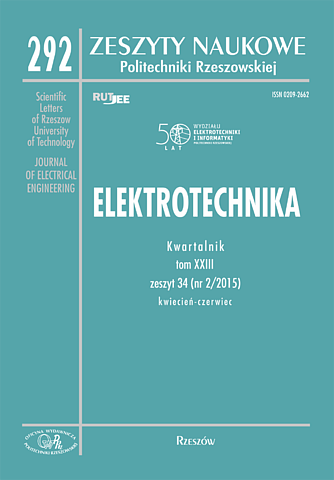Abstract
The article presents a solution to the problem of asymmetry of a three-phase voltage inverter output currents for the trajectory correction vector currents to a wheel form. The solution uses the layout described using the fuzzy logic equations. Test results apply to verify a system operation in terms of the asymmetric load. It was examined in the form of a circular trajectory of the vector output currents in case of resistant or induction asymmetry. Also not harmonics components of load currents are included. They simulate the vibrations of mechanical loads or mechanical resonance. After verification by simulations the laboratory prototype control system of inverter with equalizer in the FPGA was performed. The investigations were done on the system created for this purpose, using the field programmable gate arrays of EP3SL150F type. This system performs the task of correcting space vector of the inverter currents and, at the same time, the process of modulation waveforms. In parallel with the controlling tasks the inverter model was running in real time. The waveforms of inverter model were observed using a Signal Tap II utility or after processing into an analog signal using an oscilloscope. Observed trajectories of the currents' space vector were adjusted to the circular form in addition to the type of load asymmetry.
References
[2] Saren H., Pyrhonen O, Rauma K., Laakkonen O.; Overmodulation in Voltage Source Inverter with Small DC-link Capacitor, Power Electronics Specialists Conference, 2005, PESC '05.
[3] Kai Cai, Shanmei Cheng; A general SVM strategy for n-level m-phase converter based on voltage level, Industrial Electronics, 2008. IECON 2008. 34th Annual Conference of IEEE [4] Szostek K.: Projektowanie procesora sekwencyjnego i symulacja w środowisku MATLAB/Simulink, Pomiary Automatyka Kontrola, vol. 59, NR 10/2013, str. 1061- 1063, ISSN 0032-4140
[5] Szostek K.: Konstruowanie automatów sekwencyjnych w środowisku Matlab Simulink, Przegląd Elektrotechniczny, R. 90 NR 1/2014, str. 119-121, ISSN 0033-2097
[6] Szostek R.: Modelowanie systemów współbieżnych za pomocą sieci kolejkowych, Zeszyty Naukowe Politechniki Rzeszowskiej nr 245, z. 11, Rzeszów 2007, str. 153- 165
[7] Vinay, K.C. ; Shyam, H.N. ; Rishi, S. ; Moorthi, S., FPGA Based Implementation of Variable-Voltage Variable-Frequency Controller for a Three Phase Induction Motor, 2011 International Conference on Process Automation, Control and Computing, PACC 2011, 20-22, July 2011, Coimbatore, India
[8] Binkowski T., Korekcja trajektorii wektora przestrzennego z wykorzystaniem logiki rozmytej, Elektronika, nr 12/2012, ISSN 0033-2089, str. 35-38





